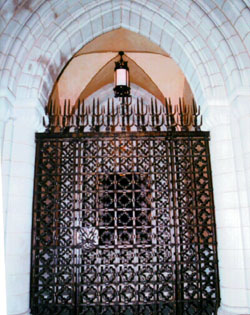On September 1, 1939, Callaway became organist and choirmaster at the Washington National Cathedral, where he founded the Cathedral Choral Society in 1941.[3] During World War II, Callaway left the Cathedral for three years to serve in the Army as a bandmaster in the South Pacific. During his tenure at the Cathedral, Callaway expanded the music program's support of American liturgical music and also oversaw considerable expansion of the organ in the 1950s–1970s as construction of the Cathedral's nave was completed.[3] He was quite short in stature, necessitating the installation of a custom-made adjustable pedalboard operated hydraulically so that Dr. Callaway could comfortably reach the pedals of the Washington Cathedral's organ.
Upon Callaway's retirement in 1977, he was succeeded at the Cathedral by his assistant organist, Richard Wayne Dirksen. Washington Post music critic Paul Hume said of Callaway at the time, "It seems incontrovertible that he has had a larger influence on the musical life of this city than any other person". Callaway then served as organist and choirmaster at St. Paul's Episcopal Church in Washington. He was a member of the Church of the Ascension and Saint Agnes in Washington, where his requiem was held following his death from cancer on March 21, 1995.[2] A memorial tuba rank was installed on the organ of the Church of the Ascension and Saint Agnes in his memory.
On September 1, 1939, Callaway became organist and choirmaster at the Washington National Cathedral, where he founded the Cathedral Choral Society in 1941.[3] During World War II, Callaway left the Cathedral for three years to serve in the Army as a bandmaster in the South Pacific. During his tenure at the Cathedral, Callaway expanded the music program's support of American liturgical music and also oversaw considerable expansion of the organ in the 1950s–1970s as construction of the Cathedral's nave was completed.[3] He was quite short in stature, necessitating the installation of a custom-made adjustable pedalboard operated hydraulically so that Dr. Callaway could comfortably reach the pedals of the Washington Cathedral's organ.
Upon Callaway's retirement in 1977, he was succeeded at the Cathedral by his assistant organist, Richard Wayne Dirksen. Washington Post music critic Paul Hume said of Callaway at the time, "It seems incontrovertible that he has had a larger influence on the musical life of this city than any other person". Callaway then served as organist and choirmaster at St. Paul's Episcopal Church in Washington. He was a member of the Church of the Ascension and Saint Agnes in Washington, where his requiem was held following his death from cancer on March 21, 1995.[2] A memorial tuba rank was installed on the organ of the Church of the Ascension and Saint Agnes in his memory.
Family Members
Sponsored by Ancestry
Advertisement
Records on Ancestry
Advertisement










